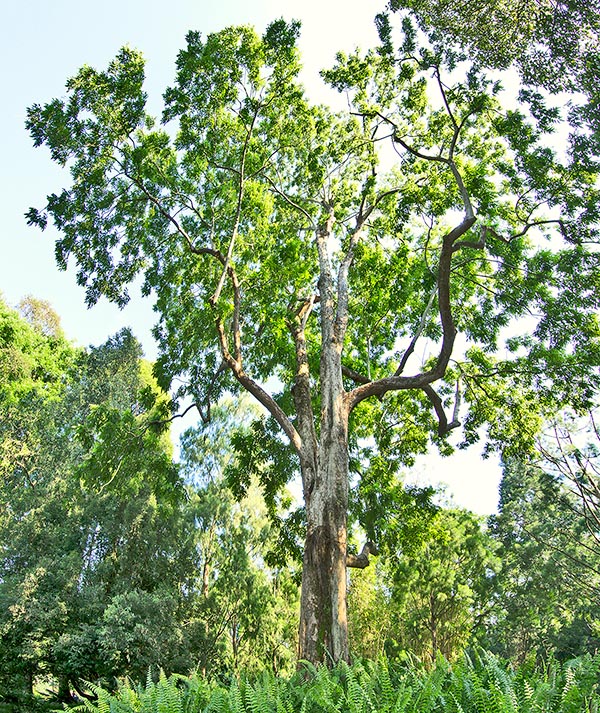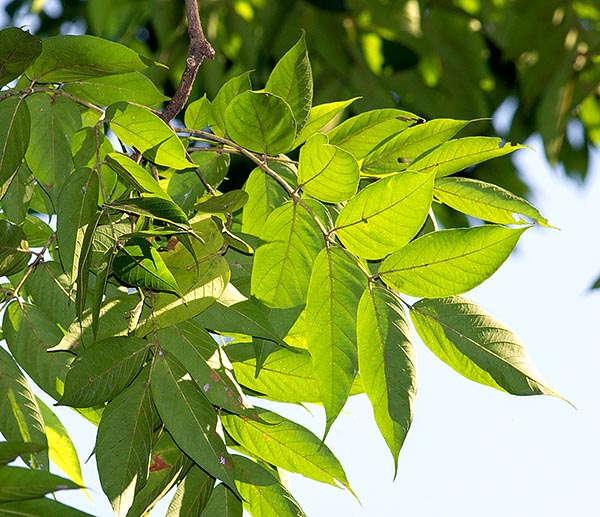Family : Bignoniaceae

Text © Pietro Puccio

English translation by Mario Beltramini

The Stereospermum fimbriatum is a 20-30 m tree native to South-East Asia © Giuseppe Mazza
The name of the genus is the combination of the Greek adjective “στερεός” (stereos) = hard and of the substantive “σπέρμα” (sperm); the specific name is the Latin adjective “fimbriatus, a, um” = fringed, with reference to the fringed lobes of the flower.
Common names: snake tree (English); paw-taw-yer, thakut-po, than-that (Burmese); khe foy (Lao); chi-a, chi-chah, cha-chah, lempoyan (Malay); khae foi, khae sai (Thai); quao tràng xẻ (Vietnamese).
The Stereospermum fimbriatum (Wall. ex G.Don) DC (1838) is a 20-30 m tall erect deciduous tree with trunk of 40-120 cm of diameter, with fissured greyish bark tending to flake off and glandulous-viscous young branches.
The leaves are opposite, odd-pinnate, 35-65 cm long, with 5-9 oblong-lanceolate leaflets with long pointed apex and slightly toothed margin, 8-18 cm long and 3-8 cm broad, of pale green colour; the young leaves have a violaceus colour.
The inflorescences are terminal panicles produced before the leaves or at the same time, viscous, bearing numerous hermephroditic flowers with tubular calyx of brownish colour, 1,5 cm long, with five short pointed lobes, imbutiform corolla of white colour with pink shades, 6-7 cm long and of 4-6 cm of diameter, with 5 lobes having finely fringed margins, two couples of stamina of different length, 1,3 and 1,7 cm respectively, and an about 2,6 cm long style.

Roots, leaves and buds are used in the traditional medicine © Giuseppe Mazza
The fruits are dehiscent capsules with almost quadrangular section, about 35-70 cm long and about 1 cm broad, twisted, containing several seeds, 2-3 cm long and 0,7 cm broad, equipped with a rather thick wing that favours their dispersion via the wind.
It propagates by seed in draining organic loam maintained humid at the temperature of 24-26 °C. Species relatively diffused in the wild, but poorly present in cultivation, utilized at times in the reforestation of degraded areas and in the consolidation of the soils and as ornamental in parks and gardens and as a road tree, in particular in the south-eastern Asian countries.
It requires a tropical or humid subtropical climate and an exposition in full sun or slightly shaded and is not particularly demanding about the soil, provided draining.
The wood, of fairly good quality, has a limited use for tools and common everyday objects; roots, leaves and buds are utilized in the traditional medicine of some local populations for various pathologies.
Synonyms: Bignonia fimbriata Wall. ex G.Don (1837); Stereospermum mekongense Dop (1930).
